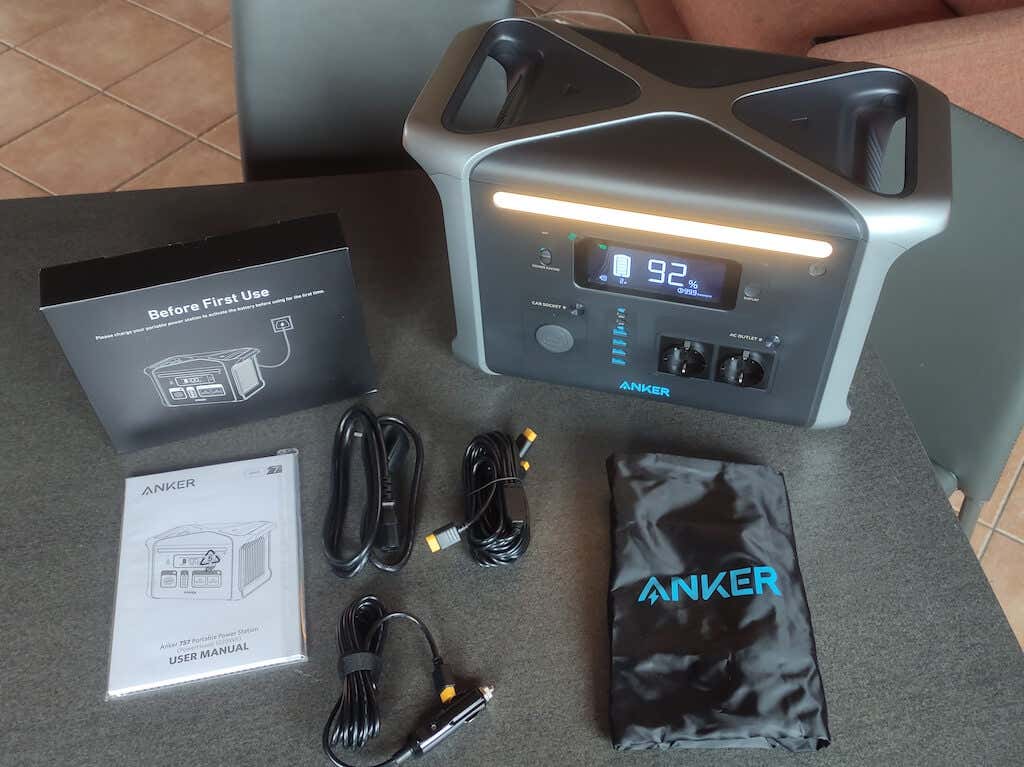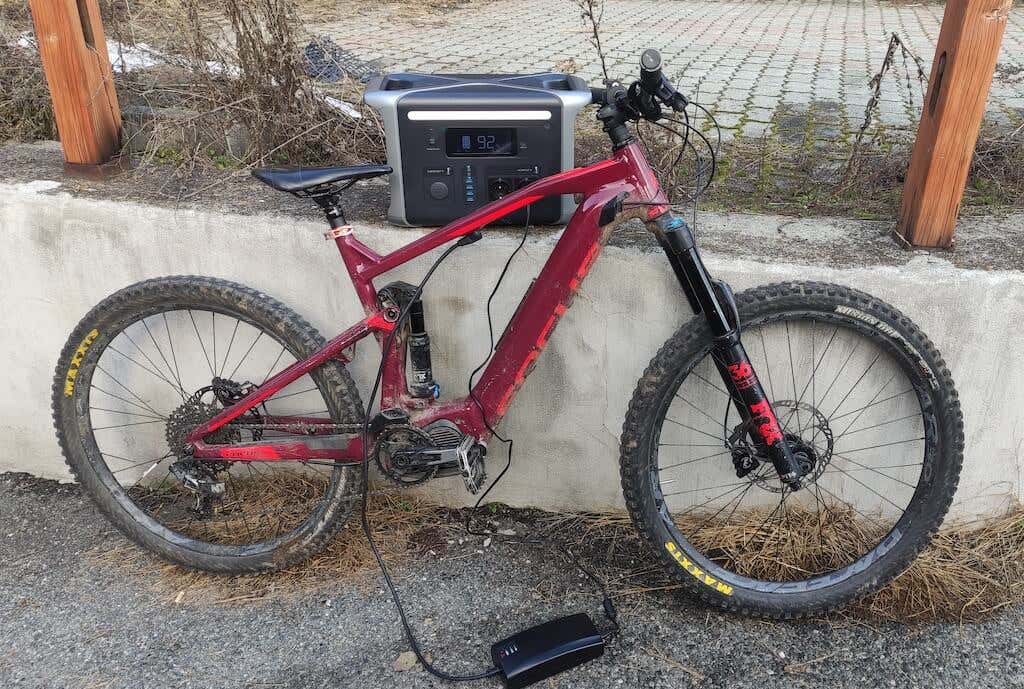What can be worse than having your smartphone battery run out on you in the most important moment, when you need to make a call or use navigation? One way to beat this is to have a charged-up power bank on you, ready to use at all times.
An even better solution would be having a whole power station with a bigger capacity that can charge not just one smartphone but any gadget you have and even double as a battery backup if you suddenly lose access to electricity.
The Anker 757 portable power station is one of the largest the company offers. It comes with a variety of ports and high output rates. The 1229 Wh lithium-ion battery capacity sounds perfect for charging multiple devices on the go if you don’t mind the steep price and the heavy build. Follow our Anker 757 PowerHouse review to see if this power station should be on your shopping list.
Anker 757 PowerHouse: First Impressions and Specs
The Anker 757 PowerHouse is a portable power station that you can take with you on a camping trip to keep your devices charged or use at home in case of a power outage. The battery capacity of 1229Wh means that this power station can run your home appliances for a good couple of hours, which should be enough in case of a sudden loss of power. The 1500W AC inverter gives enough juice to run even most appliances like electric power tools.
Here’s a full list of tech specs of the Anker 757 PowerHouse power station:
- Dimensions: 18.2 x 11.3 x 9.3 in (463 x 288 x 237 mm)
- Weight: 43.9lb (19.9kg)
- Capacity: 1229Wh
- AC Output: 1500W (Pure Sine Wave)
- AC Power Surge: 2400W
- USB-C Output: 1 x 100W max / 1 x 60W
- Car Socket Output: 120W
- AC Input: 1000W
- Solar Panel Input: 300W Max
- Recharge Time: 1.5h to charge from zero to 100%
- Solar Recharge Time: 3.6h to charge to 80%
- Price: $1299 (on Amazon, on Anker official site)
Anker has a reputation for making excellent battery products. We previously featured the power bank by Anker as one of the essential gadgets for your next outdoor adventure. The 757 PowerHouse is no exception. It’s a great addition to Anker’s line of power stations that will serve you for an extended period of time.
Aside from the impressive tech specs, the 757 comes with a five-year full-device warranty. Thanks to the Lithium Iron Phosphate (LFP) chemistry, the product can give you more than 3000 charge cycles, ensuring a long worry-free experience.
While it’s not the lightest power station, it’s still relatively small, considering how many outlets and ports Anker managed to pack in it.
Design and Unpacking
The 757 PowerHouse is a solid plastic case with two large rubber feet on the bottom to keep it stable. There’s a handle on each side of the case to help you carry the power station around. The device has a sturdy build and an exterior that’s difficult to scratch or damage.
What’s in the Box
Here’s everything you’ll find in the box when unpacking:
- 757 PowerHouse power station
- AC charging cable
- Parallel solar connector (for three solar panels)
- Car charging cable
- Dust-proof bag
- Quick start guide
The top surface of the device is flat and has a big X mark on it. The top of the power station is handy when you need to place your devices on it while charging. Thanks to the automotive-grade aluminum frame and handles, you don’t have to worry about scratching or damaging your 757 while transporting it.
On the front of the power station, you’ll find a panel with a bright LCD screen. The screen is visible even in bright daylight and shows information such as the remaining power (in percentage), as well as input and output power. The screen automatically turns off after 30 seconds to avoid wasting power.
You’ll also find various buttons to activate and deactivate sockets and the display on the front side of the unit. On the left of the display, there’s a slide switch that enables the power-saving mode, which turns off outputs that are no longer in use to save power.
Above the display, there’s an LED light strip, handy for outdoor trips and camping. There are three levels of LED light intensity, as well as an emergency SOS mode – all of which you can cycle through with a press of a button.
The PowerHouse has three output sections under the screen: one contains the AC outlets with 1500W total output, and two more are the DC ports sections for charging your small load devices. Anker 757 comes with type-A and type-C ports, which means you can ditch the bulky adapters and charge all your devices using the PowerHouse.
In total, you’ll find the 6 AC ports, 4 USB-A ports, 2 USB-C ports, and a car outlet in the output sections of your 757 – more than enough to use the station as your backup power source in case of a blackout. The USB ports of up to 100W are perfect for charging smaller devices like an iPhone or a MacBook. Meanwhile, the regulated 120W car charger can charge 12V home appliances like running a coffee maker on a camp trip.
You’ll find the input section on the back of the 757 power station. It has the main 1000W charging input and the 11-30V 10A XT-60 DC charging input for charging your 757 using the car charging cable or a solar charging cable. On the back of the PowerHouse, there’s also an AC overload protection button. You can push this button to clear the input overload circuit when the input current exceeds the permitted level.
The entire back panel with the ports is protected with a rubber cover when not in use.
Performance and Features
Thanks to the built-in fast charger, the 757 PowerHouse can draw up to 1000W from your wall and go from zero to 75-80% in just an hour on AC. Compared to the competition, this is a super fast charging speed and one of the fastest on the market.
If you choose to charge your 757 from a car outlet, it will take much longer since you’ll have limited wattage of 120W, so we recommend fully charging your station before you go camping or take it on a road trip with you.
Another option is to use solar power to charge your 757 PowerHouse. Anker recommends getting their 100W 625 solar panels, and you can use 3 of them together with your 757 to get a total of 300W of charging. This will turn your PowerHouse into a solar generator with an uninterruptible power supply and allow you to go properly off-grid. However, you can expect the charging time of your PowerHouse to increase by up to several hours using solar panels. You’ll also need to adjust them frequently to ensure your solar panels always face the sun.
If you’re planning to use your 757 to run your home computer or a 3D printer, you’ll be happy to learn about the UPS mode. In case of any disruption on the AC grid, the power station automatically switches from the AC input to the internal battery. This will help you avoid any interruption in your work in case of a power cut.
With the UPS mode on, the power station produces practically no noise. And unless the AC output is heavily loaded, you won’t hear much noise from the 757, which is great in case you’re charging something overnight. In the worst-case scenario, you’ll hear the cooling fans of the power station kick in and the noise similar to that of a cooling fan running. Generally, it’s not something that will disturb or annoy you in any significant way.
Like most other portable power stations, the Anker 757 PowerHouse doesn’t have a waterproof rating. If you’re going on a camping trip, make sure you don’t leave your 757 outside overnight, as it might not be able to handle any heavy rain. Otherwise, the protective cover included in the package should give you some weather protection.
Battery Life
Regarding battery life, Anker promises an impressive 80% charge from zero in just about one hour. In our experience, 1 hour of charge gets about 75%, and you need about 1.5 hours to charge the power station fully from zero. This fast charging speed is achieved thanks to Anker’s HyperFlash technology.
Charging times can vary depending on the temperature and the unit’s temperature. The temperature needs to be 0 – 40 °C to charge the power station.
The battery life depends on what you’ll use it for. If you go on a road trip and only use the station to charge a smartphone or a laptop and small camping supplies like a cooling fan, you’ll be good for a whole week on an initial charge. However, if you frequently need to charge your electric bike or an EUC on your trip, the PowerHouse will discharge after about 3.5 charges (this can vary depending on your e-bike).
Additionally, Anker offers a 5-year warranty that covers the full body of the 757 PowerHouse, so you don’t have to worry about how long the unit will last you. According to Anker, the station can easily last up to 10 years, even if you use it to power your devices daily.
Compared to the 2-year industry standard, the 5-year warranty is another perk that should make you consider choosing the 757 as your portable power station.
Competition
With the tendency for greener technology growing, portable power stations are becoming more popular. Unlike a gas generator, a power station like the Anker 757 doesn’t generate harmful emissions and comes with cheaper maintenance.
Some of the direct competitors of the 757 on the market are Jackery Explorer 1500, EcoFlow Delta 2, and Bluetti AC200Max. The Explorer 1500 is a few hundred dollars more expensive than the 757, and the 757 has superior manufacturing quality. The AC200Max by Bluetti is even bigger and heavier than the Anker’s 757. However, it does pack more output and capacity.
The EcoFlow Delta 2 is probably one of the best alternatives to consider if Anker’s 757 PowerHouse is slightly outside your budget. For about $900, you’ll get a similar battery to the one in 757 and the 1800W output. You won’t get any LED camping light or a UPS mode with the Delta 2, but it’s worth considering if you’re after the smaller size station.
Anker also offers smaller power stations from 256Wh to 1024Wh capacity, which you can get for as little as $249.
Should You Buy the Anker 757 PowerHouse?
Anker 757 PowerHouse is a great portable power station capable of charging all types of devices in your household on a daily basis. It’s portable enough for you to take it on multiple-day trips or short outdoor adventures. At the same time, it has enough juice to power even the most power-hungry of your home appliances.
On top of that, this LiFePO4 battery-powered station will last you up to 10 years, definitely making it your money’s worth. And if you’re looking for a power station that can replace a gas generator completely or act as a solar generator, check out the newer 767 model by Anker.
Related Posts
- Tribit StormBox 2: The Under $70 Portable Speaker that Stands Out
- ENGWE L20 2.0 Review: The Best Budget-Friendly Foldable E-Bike?
- TopDon TC004 – a Thermal Imaging Camera That Will Give You Predator Vision
- Newyes Portable Wireless Thermal A4 Printer Review
- Eskute Star Folding Fat Tire Electric Bike Review












